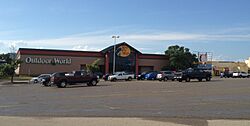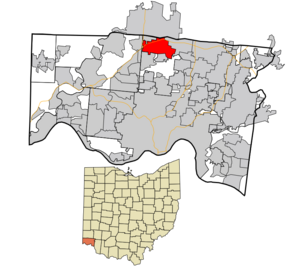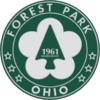Forest Park, Ohio facts for kids
Quick facts for kids
Forest Park, Ohio
|
|||
|---|---|---|---|

Part of the Forest Fair Village shopping mall
|
|||
|
|||
| Motto(s):
"Positioned For Progress"
|
|||

Location in Hamilton County and the state of Ohio.
|
|||
| Country | United States | ||
| State | Ohio | ||
| County | Hamilton | ||
| Government | |||
| • Type | Council-Manager | ||
| Area | |||
| • Total | 6.45 sq mi (16.72 km2) | ||
| • Land | 6.45 sq mi (16.70 km2) | ||
| • Water | 0.01 sq mi (0.01 km2) | ||
| Elevation | 879 ft (268 m) | ||
| Population
(2020)
|
|||
| • Total | 20,189 | ||
| • Estimate
(2023)
|
19,839 | ||
| • Density | 3,130.56/sq mi (1,208.70/km2) | ||
| Time zone | UTC-5 (Eastern (EST)) | ||
| • Summer (DST) | UTC-4 (EDT) | ||
| ZIP code |
45240
|
||
| Area code(s) | 513 | ||
| FIPS code | 39-27706 | ||
| GNIS feature ID | 1086209 | ||
Forest Park is a city in Hamilton County, Ohio, United States. It is a suburb located near Cincinnati. In 2020, about 20,189 people lived there, making it the second-largest city in Hamilton County.
Contents
Forest Park's Story
Forest Park, Ohio, was started in 1956. This was two years after two private developers, Marvin Warner and Joseph Kanter, bought a large piece of land. This land was originally part of a bigger plan from 1935 by President Franklin D. Roosevelt's government. The idea was to create "Greenbelt towns" to help families who were struggling.
The "Greenbelt" idea was stopped in 1949. The undeveloped land, which was meant for a community like Greenhills, Ohio, became available. Warner-Kanter Corporation bought it in 1954. After two years of planning, they started selling homes in Forest Park in March 1956.
Forest Park grew quickly. By 1960, about 4,800 people lived there. It became a village in 1961 and then a city in 1968. From the start, Forest Park wanted to be an "open city." This meant it welcomed people of all backgrounds, no matter their race, beliefs, or where they came from. This policy helped the city stay committed to being diverse.
To support this goal, the city created a plan in 1978. This plan aimed to fight against unfair practices by real estate agents and builders. The city council stated that "people have the right to choose where to live, work or play based on their own free choice." They believed this right should be protected for everyone.
In 1982, the "Quality of Integrated Life" resolution was passed. This guide helped the city continue to live together in harmony. It showed that diversity was a great strength for Forest Park. In 1991, this idea was again supported by a group that shared the vision of a community with many different cultures.
Where is Forest Park?
Forest Park covers about 6.48 square miles (16.72 square kilometers) of land.
Nearby Areas
Forest Park shares its borders with several other cities, villages, townships, and even another county:
- Cities
- Villages
- Townships
- Springfield
- Colerain
- Counties
People of Forest Park
Forest Park is a city with a diverse population. In 2020, the total population was 20,189 people. This means there were about 3,130 people living in each square mile.
The city has a mix of different racial and ethnic groups. In 2020, about 56% of the people were Black or African American, and about 19.9% were White. There were also significant numbers of Asian residents (6.9%) and people of Hispanic or Latino background (13.1%). Many people also identified with two or more races. This mix of cultures makes Forest Park a vibrant community.
The city had 7,517 households in 2020. About 30.4% of these households had children under 18 living with them. The average household had about 2.64 people. The average family size was 3.32 people.
In terms of age, about 24.3% of the population was under 18 years old. About 15.4% were 65 years or older. The median age in the city was 36.1 years.
The estimated average yearly income for a household in Forest Park was about $58,257 between 2016 and 2020. For families, the average income was about $73,259. About 8.4% of the people in Forest Park lived below the poverty line.
Learning in Forest Park
Most of Forest Park is part of the Winton Woods City School District. This district also serves the nearby areas of Greenhills and Springfield Township.
For reading and research, Forest Park has a local branch of the Public Library of Cincinnati and Hamilton County.
See also
 In Spanish: Forest Park (Ohio) para niños
In Spanish: Forest Park (Ohio) para niños



